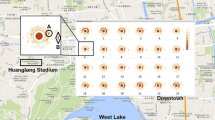Abstract
Modeling human mobility is a critical task in fields such as urban planning, ecology, and epidemiology. Given the current use of mobile phones, there is an abundance of data that can be used to create models of high reliability. Existing techniques can reveal the macro-patterns of crowd movement, or analyze the trajectory of an individual object; however, they focus on geographical characteristics. In this paper, we propose a novel data representation, the mobility transition graph, to characterize spatio-temporal mobility transition of crowd from city-wide human mobility data. We describe the design, creation, and manipulation of the mobility transition graph and demonstrate the efficiency of our approach by a case study.
Graphical abstract







Similar content being viewed by others
References
Barabasi AL (2005) The origin of bursts and heavy tails in human dynamics. Nature 435(7039):207–211
Chen W, Guo F, Wang F (2015) A survey of traffic data visualization. IEEE Trans Vis Comput Gr 16(6):2970–2984
Cui W, Liu S, Tan L, Shi C, Song Y, Gao Z, Qu H, Tong X (2011) Textflow: towards better understanding of evolving topics in text. IEEE Trans Vis Comput Gr 17(12):2412–2421
de Montjoye YA., Hidalgo CA., Verleysen M, Blondel VD (2013) Unique in the crowd: The privacy bounds of human mobility. Scientific reports 3
Doraiswamy H, Ferreira N, Damoulas T, Freire J, Silva CT (2014) Using topological analysis to support event-guided exploration in urban data. IEEE Trans Vis Comput Gr 20(12):2634–2643
Gao J, Goodman J, Cao G, Li H (2002) Exploring asymmetric clustering for statistical language modeling. In: Proceedings of the Association for Computational Linguistics, pp 183–190
Gonzalez MC, Hidalgo CA, Barabasi AL (2008) Understanding individual human mobility patterns. Nature 453(7196):779–782
Havre S, Hetzler B, Nowell L (2000) ThemeRiver: visualizing theme changes over time. In: IEEE Symposium on Information Visualization, pp 115–123
Liao ZF, Li Y, Peng Y, Zhao Y, Zhao FF, Liao ZN, Dudley S, Ghavami M (2015) A semantic-enhanced trajectory visual analytics for digital forensic. J Vis 18(2):173–184
Liu S, Wu Y, Wei E, Liu M, Liu Y (2013) Storyflow: tracking the evolution of stories. IEEE Trans Vis Comput Gr 19(12):2436–2445
Lu X, Bengtsson L, Holme P (2012) Predictability of population displacement after the 2010 haiti earthquake. Proc Natl Acad Sci 109(29):11576–11581
Ma Y, Lin T, Cao Z, Li C (2015) Mobility viewer: an eulerian approach for studying urban crowd flow. IEEE Trans Intell Trans Syst pp 1–10
Ogawa M, Ma KL (2010) Software evolution storylines. In: International Symposium on Software visualization, pp 35–42
Schneider CM, Belik V, Couronné T, Smoreda Z, González MC (2013) Unravelling daily human mobility motifs. J R Soc Interface 10(84):2013–2046
Song C, Koren T, Wang P, Barabási AL (2010) Modelling the scaling properties of human mobility. Nat Phys 6(10):818–823
Song C, Qu Z, Blumm N, Barabási AL (2010) Limits of predictability in human mobility. Science 327(5968):1018–1021
Song L, Kolar M, Xing EP (2009) Time-varying dynamic bayesian networks. In: Advances in neural information processing systems, pp 1732–1740
Sun G, Wu Y, Liu S, Peng TQ, Zhu JJ, Liang R (2014) EvoRiver: visual analysis of topic coopetition on social media. IEEE Trans Vis Comput Gr 20:(12)
Tanahashi Y, Ma KL (2012) Design considerations for optimizing storyline visualizations. IEEE Trans Vis Comput Gr 18(12):2679–2688
von Landesberger T, Brodkorb F, Roskosch P, Andrienko N, Andrienko G, Kerren A (2016) Mobilitygraphs: visual analysis of mass mobility dynamics via spatio-temporal graphs and clustering. IEEE Trans Vis Comput Gr 22(1):11–20
Wang Z, Ye T, Lu M, Yuan X, Qu H, Yuan J, Wu Q (2014) Visual exploration of sparse traffic trajectory data. IEEE Trans Vis Comput Gr 20(12):1813–1822
Wang P, Hunter T, Bayen AM, Schechtner K, González MC (2012) Understanding road usage patterns in urban areas. Scientific reports 2
Wang J, Wei D, He K, Gong H, Wang P (2014) Encapsulating urban traffic rhythms into road networks. Scientific reports 4
Wongsuphasawat K, Gotz D (2012) Exploring flow, factors, and outcomes of temporal event sequences with the outflow visualization. IEEE Trans Vis Comput Gr 18(12):2659–2668
Wu F, Zhu M, Zhao X, Wang Q, Chen W, Maciejewski R (2015) Visualizing the time-varying crowd mobility. In: SIGGRAPH Asia 2015 Visualization in High Performance Computing, SA ’15. ACM, New York, NY, USA, pp. 15:1–15:4. doi:10.1145/2818517.2818540. http://doi.acm.org/10.1145/2818517.2818540
Wu Y, Liu S, Yan K, Liu M, Wu F (2014) Opinionflow: Visual analysis of opinion diffusion on social media. IEEE Trans Vis Comput Gr 20:(12)
Xiong H, Zhang D, Gauthier V (2012) Predicting mobile phone user locations by exploiting collective behavioral patterns. In: IEEE Conference on Ubiquitous Intelligence and Computing, pp 164–171
Xu P, Wu Y, Wei E, Peng TQ, Liu S, Zhu JJ, Qu H (2013) Visual analysis of topic competition on social media. IEEE Trans Vis Comput Gr 19(12):2012–2021
Zeng W, Fu CW, Arisona SM, Erath A, Qu H (2014) Visualizing mobility of public transportation system. IEEE Trans Vis Comput Gr 20:12
Zhao J, Cao N, Wen Z, Song Y, Lin YR., Collins C (2014) FluxFlow: visual analysis of anomalous information spreading on social media. IEEE Trans Vis Comput Gr 20:(12)
Zheng X, Chen W, Wang P, Shen D, Chen S, Wang X, Zhang Q, Yang L (2015) Big data for social transportation. IEEE Trans Intell Transp Syst pp 1–11
Zheng Y, Capra L, Wolfson O, Yang H (2014) Urban computing: concepts, methodologies, and applications. ACM Trans Intell Syst Technol 5(3)
Acknowledgments
This work is supported by the National 973 Program of China (2015CB352503), National Natural Science Foundation of China (61232012, 61422211), and the Fundamental Research Funds for the Central Universities. Ross Maciejewski is supported by the National Science Foundation under Grant No. 1350573.
Author information
Authors and Affiliations
Corresponding author
Rights and permissions
About this article
Cite this article
Wu, F., Zhu, M., Wang, Q. et al. Spatial–temporal visualization of city-wide crowd movement. J Vis 20, 183–194 (2017). https://doi.org/10.1007/s12650-016-0368-4
Received:
Revised:
Accepted:
Published:
Issue Date:
DOI: https://doi.org/10.1007/s12650-016-0368-4




